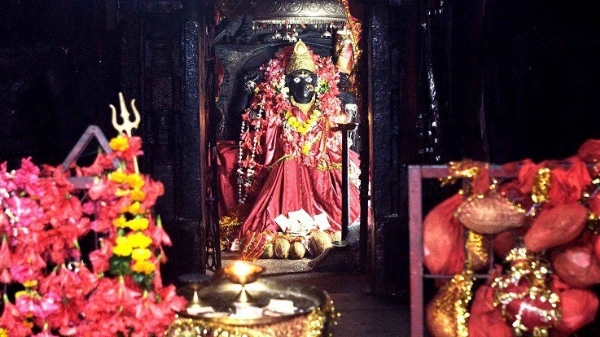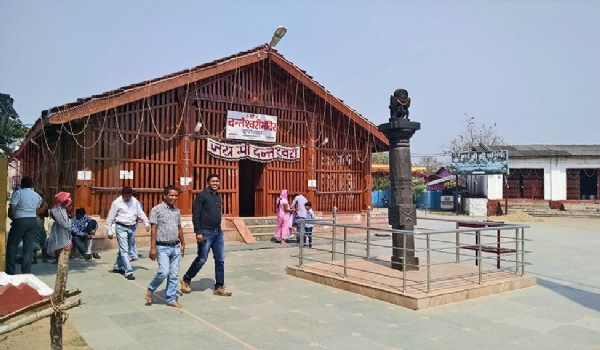One of 52 Shakti Peethas, know the legacy of Jagdalpur's Danteshwari Temple that PM Modi visited
he Danteshwari Temple is steeped in history, with its origins dating back to the 14th century. It is dedicated to Goddess Danteshwari, an incarnation of Goddess Shakti or Kali or Durga.
Total Views |
Prime Minister Narendra Modi today visited the ancient Danteshwari temple of Jagdalpur, while he was visiting Chhattisgarh. He was in the Chhattisgarh town to lay foundation stones for multiple projects, aimed at enhancing socioeconomic growth and 'Ease of Living' for the people. The Danteshwari Temple in Jagdalpur is among the many treasures of the state, that stands as a symbol of devotion and cultural significance.

Historical Roots
The Danteshwari Temple is steeped in history, with its origins dating back to the 14th century. It is dedicated to Goddess Danteshwari, an incarnation of Goddess Shakti or Kali or Durga. The temple's name is derived from the word "Danteswari," which means the "Goddess who rescues from toothache." According to local legends, the temple was constructed by the Chalukya kings and has since undergone several renovations.
The temple holds immense historical significance as it is believed to be one of the 52 Shakti Peethas, where a part of Goddess Sati's body fell during Bhagwan Shiva's Tandava (cosmic dance). This legend adds to the spiritual aura of the temple and attracts pilgrims from far and wide.
Architectural Marvel
One of the striking aspects of the Danteshwari Temple is its architectural splendor. The temple exhibits a blend of Nagara and Dravidian architectural styles, showcasing intricate carvings, ornate pillars, and a grand entrance gate. The sanctum sanctorum enshrines the idol of Goddess Danteshwari, adorned with traditional ornaments and garments.
The temple complex is vast and includes other shrines dedicated to various deities, such as Bhagwan Shiva, Bhagwan Vishnu, and Bhagwan Ganesha. The intricate stone carvings on the walls depict mythological stories and cultural motifs, providing a visual treat to visitors and historians alike.
VIDEO | PM Modi visits Jagdalpur temple in Chhattisgarh ahead of laying foundation stones of several projects worth Rs 26,000 crore, including the NMDC's steel plant, in the city. pic.twitter.com/tanm6gSjY2
— Press Trust of India (@PTI_News) October 3, 2023
Religious Significance
The Danteshwari Temple holds immense religious significance, not only for the people of Chhattisgarh but also for devotees from across India. It is considered a sacred center of worship and spirituality, drawing pilgrims and tourists throughout the year. Here are some key aspects of its religious significance:
1. Goddess Danteshwari: The main deity, Goddess Danteshwari, is revered as the presiding deity of the Bastar region. Devotees flock to the temple to seek her blessings for health, prosperity, and protection from ailments.
2. Festivals and Rituals: The temple comes alive during various festivals and rituals. Navaratri is a grand celebration here, attracting thousands of devotees who participate in the vibrant processions and religious ceremonies. The temple also plays a crucial role during the Bastar Dussehra festival.
3. Spiritual Atmosphere: The serene ambiance of the temple complex, surrounded by lush greenery and the sound of temple bells, offers a peaceful retreat for meditation and spiritual contemplation.
4. Cultural Heritage: Danteshwari Temple is not just a place of worship but also a repository of Chhattisgarh's cultural heritage. The temple's architecture, rituals, and festivals showcase the state's rich traditions and artistic excellence.
Bastar Dussehra Festival

One of the most significant events associated with the Danteshwari Temple is the Bastar Dussehra festival. This annual extravaganza is celebrated with great pomp and grandeur in the Bastar region, primarily in Jagdalpur. Bastar Dussehra is unique in several ways:
1. Longest Dussehra Celebration: Bastar Dussehra spans over 75 days, making it one of the longest Dussehra celebrations in the world. The festival typically begins in July or August and continues until October.
2. Indigenous Traditions: Unlike traditional Dussehra celebrations, Bastar Dussehra is deeply rooted in the indigenous customs and traditions of the tribal communities in Chhattisgarh. It showcases the tribal culture, music, and dance forms, providing a glimpse into the rich heritage of the region.
3. Devotees and Processions: The highlight of Bastar Dussehra is the grand procession of the local deities, accompanied by traditional instruments and dances. Devotees from neighboring villages and towns come to witness this spectacle and seek the blessings of Goddess Danteshwari.
4. Dussehra Rituals: The festival culminates with the immersion of the idols of local deities in the rivers. This ritual signifies the return of the deities to their respective abodes and the end of the monsoon season.
Tourist Attraction
Apart from its religious and cultural significance, the Danteshwari Temple also serves as a major tourist attraction. Jagdalpur and the surrounding Bastar region offer visitors a chance to explore the natural beauty and tribal culture of Chhattisgarh. Some nearby tourist spots include:
1. Chitrakote Waterfalls: Known as the "Niagara of India," Chitrakote Waterfalls is a breathtaking natural wonder located just a few hours from Jagdalpur.
2. Kanger Valley National Park: This national park is home to diverse flora and fauna and offers opportunities for wildlife enthusiasts and nature lovers.
3. Tribal Villages: Visitors can explore the unique lifestyle and traditions of the tribal communities in Bastar by visiting nearby villages like Kondagaon and Narayanpur.
The Danteshwari Temple of Jagdalpur stands as a testament to the rich cultural and religious heritage of Chhattisgarh. Its historical roots, architectural marvel, religious significance, and the grandeur of the Bastar Dussehra festival make it a must-visit destination for pilgrims, history enthusiasts, and tourists alike. The temple not only serves as a place of worship but also a bridge that connects people to the spiritual and cultural essence of this vibrant region.
--

